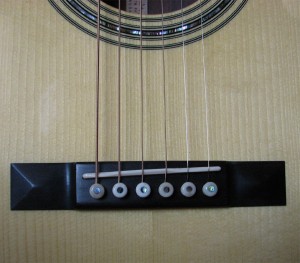A Bone Saddle and a Gloss Top add a lot to the Martin D1GT.
Gary K. writes:
I recently bought a D-1GT and I really love it. Currently upgrading to bone from the factory plastic hardware. I have a question regarding Martin naming convention. I know that the “D” stands for dreadnought and “OM” orchestral model. What do the last part of the model name (the “GT”) stand for?
Spoon replies:
Hi Gary, thanks for your question and congratulations on the guitar.
“GT”
The GT stands for Gloss Top. The D-1 and some other models came with a satin finish on the top. The GT version includes the upgrade of a high-gloss finish on the top, which is resistant to dings and pick wear, and gives the guitar a look similar to more expensive models. Your D-1GT is among the best values Martin has ever offered.
Upgrading from plastic hardware
A bone saddle can provide greater definition, sustain and purer fundamental notes off the strings of an acoustic guitar, well worth the effort and expense.
When one upgrades to a new bone saddle they may find that things sound a bit shrill. But that only lasts a short while. After the guitar is played for several days that will burn off, leaving a clear, transparent ring.
The nut material at the top of the fingerboard matters as well, but not nearly as much as the saddle.
Other material used for saddles and nuts include tusks or jaw bones from various animals, as well as fossilized ivory – which is actually only partially mineralized.
Fossilized walrus ivory and fossilized mammoth ivory are most common. Of the two, I prefer the mammoth. Both add some warmth and roundness to the tone of a guitar, which can be a welcome addition to a guitar with a brand new Adirondack spruce top, since Adirondack is usually pretty tight and brittle sounding for the first year or two. But in exchange, the guitar will lose some high end sparkle. So it can be a tradeoff. FMI seems to take away less of that Adi chime than the Walrus variety.
Overall, I find plain old bone, usually from a cow shin, is virtually identical in tone to the elephant ivory commonly used on guitars in the eighteenth and early nineteenth century.
Many also change to bridge pins made of bone, or other natural materials. While bridge pins are not nearly as important as the saddle in terms of sound production and tone, they do make a difference. But Martins have shipped with pins made of one sort of plastic or another since the 1920s and many people are happy with their guitars, without the need to switch out the pins.
– TSP

We’d like to know YOUR opinion on bone saddles!
Please leave us a comment below
If you have your own question to ask Spoon, please drop us a line at
guitar@onemanz.com